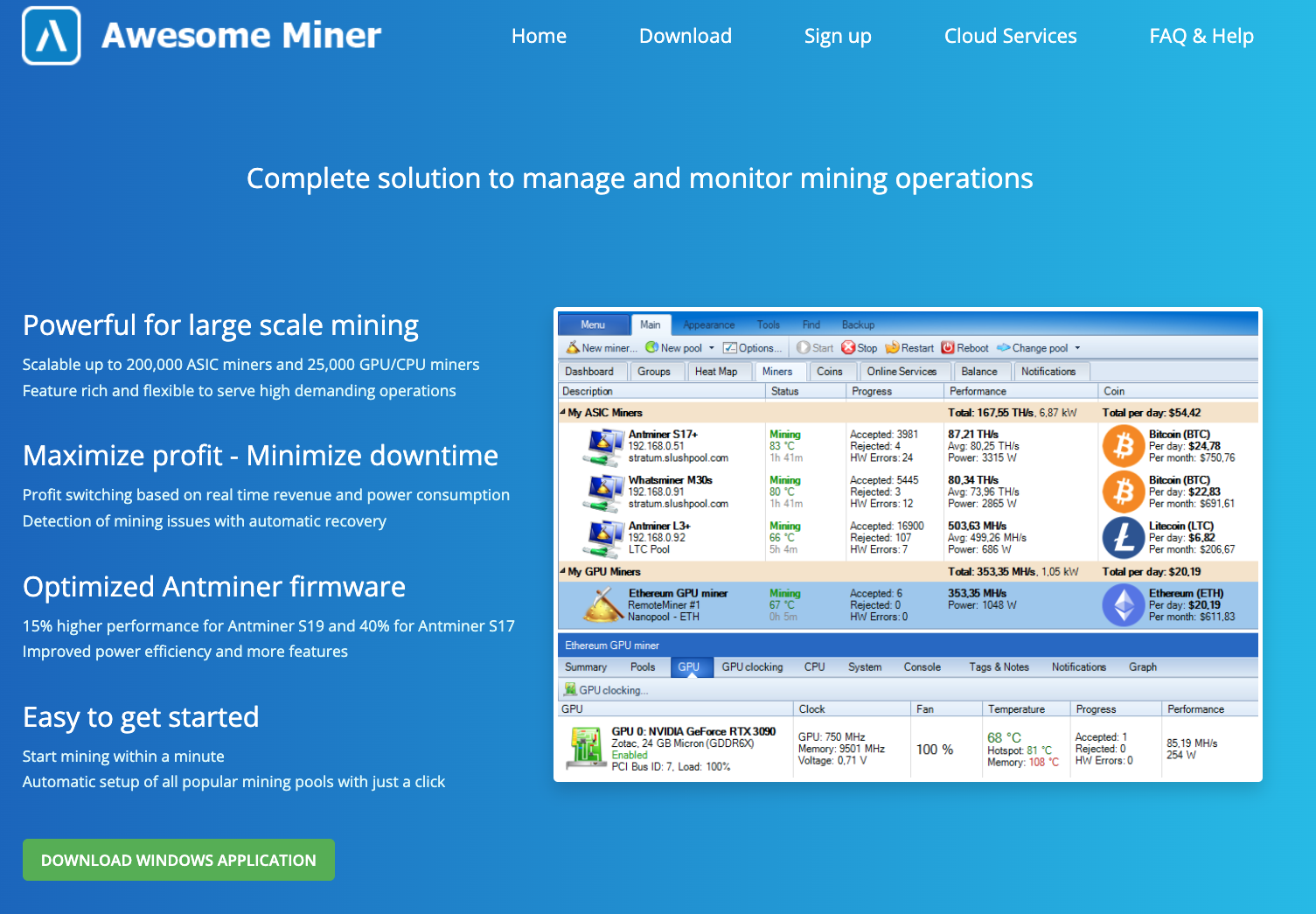Key Takeaways
- Hashing power refers to the speed at which a computer verifies crypto transactions and records them on the blockchain, with higher hashing power resulting in more earnings from mining.
- Factors such as hardware specifications, mining software, pool mining, and environmental conditions can affect hashing power.
- Determining hashing power involves understanding the underlying hashing algorithm, measuring the hash rate of hardware, and calculating the total hashing power by combining individual hash rates.
- Accurately determining hashing power is important for mining profitability, network security, and network consensus in the blockchain ecosystem.
Put simply, hashing power is the speed at which a computer verifies the legitimacy of a crypto transaction and records it on the blockchain.
The miner (computer performing this verification process) usually gets a small reward in exchange as well for contributing its processing power. So, in most cases, more hashing power equals more earnings from mining.
From our experience, you need to understand how to calculate hashing power if you want to run a profitable mining operation. With that in mind, let’s take a closer look at what hashing power is.
What is Hashing Power?
Let’s start from the top. The legitimacy of most crypto transactions needs to be verified before they can be added to the underlying blockchain. This verification process usually involves a computer doing a lot of complex calculations.
The speed at which a computer can complete these calculations is called its hashing power or hash rate of that system. Some common hash rate terms that you should know about are:
- Kilohash: 1,000 hashes per second or 1 khash/s;
- Megahash: 1 million hashes per second or 1 Mhash/s;
- Gigahash: 1 billion hashes per second or 1 Ghash/s;
- Terahash: 1 trillion hashes per second or 1 Thash/s.
Hashing power and cryptocurrency mining
As we mentioned above, the computers that offer their processing power for solving these equations and calculations get a reward for their contributions.
For cryptocurrencies like Bitcoin, new coins are created every time a block of 2,000 transactions is verified and calculated completely. These new coins are then divided among the miners based on the number of hashes they solved. More hashing power leads to faster block completion which, in turn, leads to more frequent and larger rewards.
Factors that affect hashing power
Hashing power is a very variable number and can change based on a number of factors. For example, more powerful computer hardware generally equals higher hashing power. But, the type of cryptocurrency you’re mining matters as well, as different coins have different base requirements for transaction completion.
How to Determine Hashing Power?
You can think of hashing power as the total amount of hashes that your system can solve.
Determining this number requires a complete understanding of the underlying crypto-hashing algorithm. You then use this knowledge to figure out the hash rate of your system and then calculate the hashing power as a whole.
There are also a number of hardware and software tools that can help in this process. Here’s how:
Steps to calculate hashing power
This is the step-by-step method we use to determine hashing power when building a mining rig:
1. Understanding the algorithm
As we mentioned earlier, different crypto assets use different hashing algorithms and thus require a different type of processing for effective hashing.
Bitcoin, for example, uses the 256 bits hash function called SHA-256, with a block size between 1-2 MB. At the time of writing, a dedicated ASIC miner is the best option to mine on this algorithm.
On the other hand, Monero uses the randomx hashing algorithm that works well on common CPUs from Intel and AMD.
2. Measuring the hash rate
Once you have the optimal setup for mining a particular crypto asset, it’s time to determine the average hashing speed of your hardware. The simplest method for this is to look online.
For instance, let’s say you’re mining Bitcoin on the newly launched RTX 4070 and an older GTX 1080 ti. You can find the average expected hash rate for both of these GPUs online.
Alternatively, you can also use benchmarking software — like PG Bench — to determine the exact hash rate of your system. Finding the right software and running the test will take more time, but it will also provide more accurate results.
3. Calculating the hashing power
After you’ve calculated the hash rate of all of your different mining GPUs, CPUs, or dedicated ASICs, all you have to do is add them together.
For example, let’s say the hash rate of the two GPUs in your system is 80 Mhash/s and 60 Mhash/s. Plus you also have an ASIC miner which operates at around 190 Mhash/s. In this situation, the hashing power of your mining setup would be (80+60+190) 330 Mhash/s.
Tools for measuring hashing power
The manual method we mentioned above is perfectly valid for most miners, but it does take some time to complete. Here are some tools you can use to speed up the process:
Mining hardware
Application-Specific Integrated Circuits (ASICs) are computers that are designed for the sole purpose of efficient crypto mining. One of the best parts about these dedicated mining hardware systems is that they’re very consistent with their hash rate.
So, all you have to do is look up the minimum guaranteed hash rate for your ASIC miner and add them all together to get total hashing power.

Mining software
Mining software — like Awesome Miner — also comes with built-in hash rate benchmarking features. They test the hashing performance of all of your connected hardware and output the total hashing power of your setup fairly accurately.
Online calculators
Online calculators determine the hashing power and overall profitability of your mining system. All you have to do is input the average hash rate you’re getting, the electricity costs in your area, and the amount of power your setup uses.
Some online hashing power calculators we’ve had a good experience with include:
Factors Affecting Hashing Power
From what we’ve seen over the years, these are the factors that have the largest impact on your hashing power:
Hardware specifications
Many believe that the most powerful hardware will have the best hashing power. While this is true to some extent, the exact type and specifications of your hardware matter as well. For example, ASICs often have more hashing power than the latest GPUs, even if they have less raw processing power.
Mining software
The software you use for mining can also determine the final hashing power of your system. For example, software designed for mining on Nvidia GPUs won’t perform as well on AMD-based systems.
Pool mining
Joining a pool will usually increase your hashing power as you’ll be combining resources with other mining rigs across the world. However, different mining pools have different requirements and offer different benefits. So, make sure to find the one that best fits your hardware and location.
Environmental factors
If you live in a hot environment, your mining hardware will get hotter, which will lower its processing power. This is why many miners use robust air conditioning to keep their mining rooms as cold as possible.
Importance of Accurately Determining Hashing Power
Hashing power has direct correlations with many core aspects of cryptocurrencies and blockchain networks. The most important reasons to accurately determine hashing power are:
Impact on mining profitability
It’s simple math really. Operating a crypto mining setup has a lot of costs like electricity and climate control.
If your mining setup has high hashing power, it will be able to solve more hashes per second and earn more frequent rewards.
So, a system with higher hashing power will generate more revenue while using the same amount of electricity.
For example, let’s say your operational costs are $100 and your low hashing power rig generates $150 worth of crypto per month. You’ll only get $50 in profits without accounting for the initial setup and future maintenance costs.
But, if you use a more efficient system with a higher hashing power, it might generate $250 worth of crypto every month — increasing your profits by $100.
Effect on network security
Networks with higher hash rates are more secure. This is because higher hashing power makes it difficult for bad actors to perform a 51% attack and manipulate the blockchain's transaction history.
Role in network consensus
Accurate measurement of a network’s hashing power is essential to ensure the blockchain’s integrity. A higher hashing power usually means more nodes in the system, which — in turn — results in a more accurate ledger consensus.
Conclusion
Hashing power is an important metric in crypto. For individual miners, it is a deciding factor in the profitability of their setups. On the other hand, it also determines the security and consensus accuracy of the network as a whole.
Fortunately, determining the hashing power of your rig is a fairly straightforward process. You do it manually or use automated benchmarking tools to make this process even faster.
Whichever method you use, make sure that the hashing power you calculate is accurate and up-to-date with the latest crypto-mining environment.


